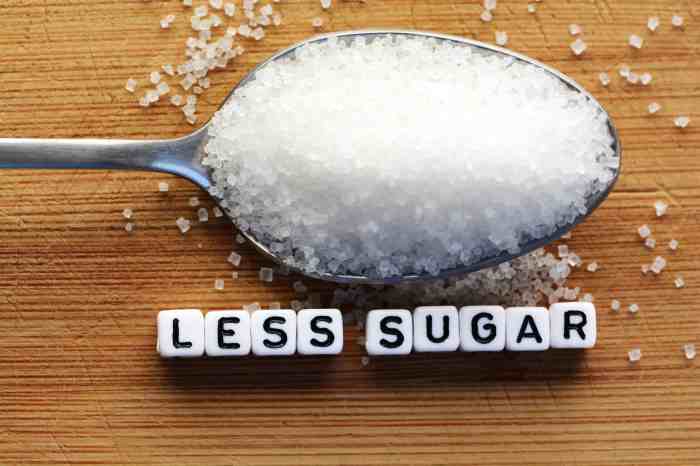Dive into the world of “less sugar less fat crossword,” where puzzles and health converge. As we delve into this topic, we’ll unravel the significance of reducing sugar and fat intake, decipher food labels, and uncover strategies for a balanced diet.
Prepare to embark on a crossword-inspired journey towards a healthier lifestyle.
Uncover the criteria that define “less sugar less fat” products, empowering you to make informed choices at the grocery store. We’ll explore the health benefits of embracing a less sugar less fat diet, supported by data and statistics.
Less Sugar Less Fat

Less sugar less fat is a dietary approach that emphasizes reducing the intake of added sugars and unhealthy fats. It focuses on consuming nutrient-rich foods that are naturally low in these components, such as fruits, vegetables, whole grains, and lean protein sources.
Less sugar, less fat crossword puzzles can be a fun way to challenge your knowledge of healthy eating habits. If you’re looking for a more in-depth exploration of ancient history, you might want to check out a labeled map of ancient Greece . This map provides a detailed overview of the region, including major cities, rivers, and mountains.
Returning to the topic of crosswords, remember that less sugar less fat crossword puzzles can help you stay sharp and improve your vocabulary.
Health Benefits of Reducing Sugar and Fat Intake
Reducing sugar and fat intake has numerous health benefits, including:
- Lower risk of obesity, heart disease, and type 2 diabetes
- Improved blood sugar control
- Reduced inflammation
- Increased energy levels
- Improved mood and cognitive function
Prevalence of Sugar and Fat Consumption
According to the World Health Organization, adults should consume less than 10% of their daily calories from added sugars. However, many people exceed this recommendation, with some studies indicating that the average person consumes up to 20% of their daily calories from added sugars.
Similarly, unhealthy fat consumption is a significant concern. The American Heart Association recommends that no more than 25-35% of daily calories come from total fat, with less than 7% coming from saturated fat. However, many people consume more than these recommended amounts, increasing their risk of heart disease and other health problems.
Identifying Less Sugar Less Fat Products

Identifying products labeled as “less sugar less fat” requires understanding the criteria and using food labels effectively.
Criteria for Labeling Products as “Less Sugar Less Fat”
To qualify for the “less sugar less fat” label, products must meet specific criteria set by regulatory bodies. In general, products must have:
- At least 25% less sugar than similar products.
- At least 25% less fat than similar products.
Role of Food Labels in Identifying These Products
Food labels play a crucial role in identifying “less sugar less fat” products. Look for the “Nutrition Facts” panel on food packaging. It provides detailed information about the product’s nutritional content, including the amount of sugar and fat.
Compare the “Nutrition Facts” panel of different products to identify those that meet the “less sugar less fat” criteria.
Examples of Products that Meet the “Less Sugar Less Fat” Criteria
Examples of products that meet the “less sugar less fat” criteria include:
- Low-fat yogurt with fruit
- Whole-wheat bread with reduced sugar
- Reduced-fat milk
Dietary Considerations for Less Sugar Less Fat
Maintaining a balanced diet that limits sugar and fat intake is crucial for overall well-being. Excessive consumption of these substances can lead to a range of health concerns, including weight gain, heart disease, and diabetes.
Incorporating more fruits, vegetables, and whole grains into your diet provides essential nutrients and fiber, promoting satiety and reducing cravings for sugary and fatty foods.
Benefits of a Balanced Diet
- Supports a healthy weight
- Reduces the risk of chronic diseases
- Improves digestion and regularity
- Enhances energy levels
- Promotes overall well-being
Risks of Excessive Sugar and Fat Consumption
- Weight gain and obesity
- Increased risk of heart disease
- Type 2 diabetes
- High blood pressure
- Tooth decay
Strategies for Reducing Sugar and Fat Intake: Less Sugar Less Fat Crossword

Reducing sugar and fat intake is essential for maintaining a healthy lifestyle. Here are some strategies to help you achieve this goal:
To make healthier choices, it is important to be aware of the amount of sugar and fat in the foods you consume. Reading food labels carefully can provide you with this information. Additionally, it is beneficial to cook more meals at home, as this gives you control over the ingredients and portion sizes.
Tips for Reducing Sugar and Fat Intake
| Tip | Explanation |
|---|---|
| Limit sugary drinks | Sugary drinks are a major source of added sugar. Choose water, unsweetened tea, or sparkling water instead. |
| Choose whole grains over refined grains | Whole grains contain more fiber, which helps you feel full and satisfied. |
| Read food labels | Pay attention to the serving size and the amount of added sugar and fat in foods. |
| Cook more meals at home | This gives you control over the ingredients and portion sizes. |
| Use healthy cooking methods | Choose methods like grilling, baking, or steaming instead of frying. |
| Add flavor with herbs and spices | Instead of adding sugar or fat, use herbs and spices to flavor your dishes. |
Healthy Snacks and Meals
Here are some healthy snacks and meals that are low in sugar and fat:
- Fruits and vegetables
- Whole-wheat bread or crackers
- Yogurt
- Nuts and seeds
- Grilled chicken or fish
- Brown rice
- Lentils
- Soups and stews
Resources and Support Groups
If you are struggling to reduce your sugar and fat intake, there are resources and support groups available to help you. Here are a few examples:
- The American Heart Association
- The National Diabetes Association
- Weight Watchers
- Local support groups
Challenges and Successes in Reducing Sugar and Fat
Reducing sugar and fat intake can be a challenging endeavor, but it is certainly achievable with the right mindset and strategies. Here are some common challenges individuals face, along with tips for overcoming them:
Cravings and temptations, Less sugar less fat crossword
- Cravings for sugary and fatty foods are common when trying to reduce their intake. To overcome this, it’s helpful to identify triggers that lead to cravings and find healthier alternatives.
- Planning meals and snacks ahead of time can help prevent impulsive decisions when hunger strikes.
- Gradually reducing sugar and fat intake rather than abruptly cutting them out can help minimize cravings.
Lack of willpower
- Staying motivated and maintaining willpower can be difficult, especially during social gatherings or stressful situations.
- Setting realistic goals and rewarding oneself for progress can help boost motivation.
- Seeking support from friends, family, or a support group can provide encouragement and accountability.
Success stories
Many individuals have successfully reduced their sugar and fat intake, leading to significant health benefits. Here are a few testimonials:
“After struggling with weight gain and fatigue, I decided to cut down on sugary drinks and processed foods. I started by making small changes, like replacing soda with water and opting for whole grains over white bread. Over time, my cravings for unhealthy foods diminished, and I started feeling more energized and healthier overall.”
“Reducing fat intake was challenging at first, but I found that cooking more meals at home and using leaner cuts of meat made a big difference. I also learned to enjoy healthy fats, like avocados and nuts, which helped me feel satisfied and reduce my cravings for unhealthy fats.”
Essential FAQs
What’s the significance of reducing sugar and fat intake?
Excessive sugar and fat consumption can contribute to weight gain, heart disease, and other health issues. Reducing these nutrients promotes overall health and well-being.
How can I identify “less sugar less fat” products?
Look for food labels that meet specific criteria, such as containing less than 5 grams of added sugar and less than 3 grams of total fat per serving.
What are some tips for reducing sugar and fat intake?
Opt for fruits, vegetables, and whole grains over processed foods. Limit sugary drinks and choose lean protein sources. Cook meals at home to control ingredients and portion sizes.